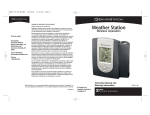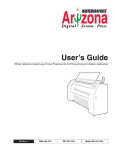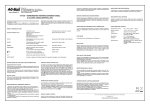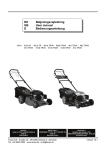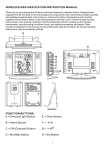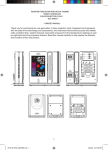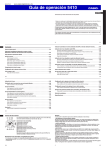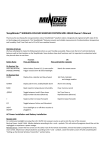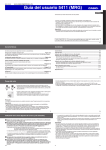Download Digital Projection
Transcript
GARANTÍA LIMITA DA POR UN AÑO (Válida únicamente en los EE. U U.) Este producto está garantizada contra defectos en los materiales de fabricación o de mano de obra de por vida para el comprador original, a partir de la fecha de compra al por menor. No cubre daños ni desgastes que sean consecuencia de accidentes, uso inadecuado, abuso, uso comercial ni ajustes y/o reparaciones no autorizadas. Digital Projection Thermometer Si este producto requiere mantenimiento (o cambio a nuestro entender) mientras esté en garantía, sírvase empacar el artículo cuidadosamente y envíelo con el franqueo pagado, junto con el recibo de la tienda en el que aparezca la fecha de compra y una nota explicando el motivo de la devolución a: Taylor Precision Products 2220 Entrada Del Sol Las Cruces, New Mexico 88001 www.taylorusa.com No existen garantías expresas excepto las enunciadas anteriormente. Esta garantía le otorga derechos legales específicos y es posible que usted tenga otros derechos que varían de un estado a otro. ©2006 Taylor Precision Products y sus compañías afiliadas, todos los derechos reservados. Taylor® y Leading the Way in Accuracy® son marcas registrada de Taylor Precision Products y sus compañías afiliadas. Todos los derechos reservados. Fabricado en China según nuestras especificaciones exactas. Instruction Manual and Warranty Information 1497 5.06 1497 GETTING STARTED 1. IMPORTANT: Insert power supply cord into the home receiver unit first. Home Receiver: • Insert the AC Adaptor Jack into the back of the unit and insert the cord into a 120V household outlet. • As a back up or alternate power source, install 2 alkaline AA batteries according to the polarity indicated. Close the battery cover. 2. Remote Sensor: Loosen the 4 screws securing the battery cover with a small screwdriver (included) and remove. Insert 2 alkaline AAA batteries according to the polarity direction indicated. Replace the cover and tighten the 4 screws. 3. Place the home receiver as close as possible to the remote sensor. This will help with synchronization between the two units. 4. REMEMBER: Once you are ready to position your remote sensor and the home receiver, ensure that the distance is not outside the effective transmission range (100 feet). Some building materials and location of the home receiver or remote sensor can affect transmission quality and range. Try various locations for best results. NOTE: There are no consumer serviceable parts. All questions or service requests should be directed to our customer service department. (See Warranty section for contact information.) SETTING TIME RADIO-CONTROLLED CLOCK The home receiver will start synchronizing the clock after the 1st channel of the RF thermometer is registered. 1. At normal mode, hold the “ - ” button located on the back of the home receiver for 3 seconds to force synchronization. 2. The antenna icon will appear during the synchronization process (on the right side of the time display). 3. If the icon disappears afterwards, radio time signal is not available at that moment. Try setting the home receiver in other locations. Remember to place the unit away from sources of interference such as mobile phones, appliances, TV etc. 2 4. Antenna icon will appear on screen if the radio time reception is successful. The radio-controlled clock will have a daily synchronization at 1:00 am everyday. If previous attempts of reception were unsuccessful, the home receiver will attempt synchronization each hour until successful. 5. Each reception cycle is minimum 2 minutes and maximum 10 minutes. TIME ZONE SELECTION Press “ - ” button on back of home receiver to select from the following time zones in the U.S. (zone is displayed in the upper right hand corner of time display). P - Pacific Standard Time C - Central Standard Time M - Mountain Standard Time E - Eastern Standard Time MANUAL SETTING FOR CLOCK & CALENDAR 1. Hold “SET ” button for 3 seconds to enter clock set. 2. First, select 12 hour or 24 hour setting using the “ + , - ” buttons located on the back of the home receiver. Press “ SET ” button to confirm. Now you will select the calendar settings3. Select Year - Use the “ + , - ” buttons located on the back of the home receiver to adjust year setting. Press “ SET ” button to confirm. 4. Select Month - Use the “ + , - ” buttons located on the back of the home receiver to adjust month setting. Press “ SET ” button to confirm. 5. Select Day - Use the “ + , - ” buttons located on the back of the home receiver to adjust day setting. Press “ SET ” button to confirm. 6. Select Hour - Use the “ + , - ” buttons located on the back of the home receiver to adjust hour setting. Press “ SET ” button to confirm. 7. Select Minute - Use the “ + , - ” buttons located on the back of the home receiver to adjust minute setting. Press “ SET ” button to confirm. 8. DST On/Off (Daylight Savings Time) - Use the “ + , - ” buttons to turn DST on or off. Press “ SET ” button to confirm. 9. Select Centigrade/Fahrenheit Temperature Readings - Use the “ + , - “ buttons located on the back of the home receiver to select Fahrenheit or Centigrade. Press “ SET ” button to confirm. 3 TEMPERATURE/ HUMIDITY ALERT SETTING ALARM TIME 1. Hold the “CLEAR” button for 3 seconds. 2. To select either first alarm (A1) or second alarm (A2) - Press “ + , - ” on back to toggle between selections. Press “CLEAR” to confirm your selecton. 3. Set alarm time - Press “ + , - ” on the back of the unit to enter the desired Hr/ Min values. Press “CLEAR” to confirm. 4. To view alarm time - Press “CLEAR” button. Alarm time will display for 5 seconds and then resume to normal clock thereafter. 5. To select between alarm 1, alarm 2 or alarm off - Press “ + “ button on the back of the unit. For Daily Alarm - The appropriate “” icon will appear in the upper left corner of the time display. No Alarm - The “” icons will not be shown. 6. The home receiver will provide either a daily alarm, which last for 2 minutes or a snooze mode where the alarm will repeat every 10 minutes until manually cleared (see SNOOZE/LIGHT section below.) 7. To turn alarm off - Simply press any button under the LCD display. 8. To deactivate alarm - Press “ + “ button on the back of the unit until the alarm icons are not shown. SNOOZE/ LIGHT 1. Press the SNOOZE/LIGHT button for an extended backlight. 2. In snooze alarm mode, press this button to trigger a repetitive snooze alarm. Press “ALERT” on back of unit to turn temperature & humidity alert on and off. 1. Hold “ALERT” button located on back of home receiver for 3 seconds to enter the alert setting mode. The indoor icon will flash. 2. Press “ +, - ” to select the between indoor temperature, indoor humidity or remote sensor channels to be alerted to. Press “ALERT” to confirm your selection. The Upper pointer and the value on the LCD display will flash, enter the desired upper limit with the “ +, - ” buttons, press “ALERT” to confirm your selection and then go to the lower limit setting. 3. The Lower pointer and value will flash, enter the desired lower limit with “ +, - ” buttons, press “ALERT” to confirm and exit. 4. You may enter an alert setting for the indoor temp, indoor humidity and remote sensor temperature. 5. When the temperature hits the limit of your preset levels, the Upper/Lower pointers and the temperature of the respective channel (indoor or remote sensor) will flash and produce an audible alarm. Press any button on the home receiver to acknowledge and stop the alarm. 6. To deactivate the alert alarm – press “ALERT” until the upper/lower pointer icons are not shown. MIN/ MAX MEMORY SETTINGS 1. Press ”MIN/ MAX“ button to view the maximum values for 5 seconds. Press again to view the minimum values. 2. To clear the memory record, press “CLEAR” while the respective values are displayed on screen. TEMPERATURE TREND INDICATOR: In the upper right hand corner of the home receiver LCD display, you will see one of 3 icons; will indicate Rising Temperature readings if it changes more than 1 degree in an hour will indicate Steady Temperature readings will indicate Falling Temperatures if it is more than 1 degree in an hour. 4 USING THE PROJECTION FEATURE (Only when powered by adaptor.) The projection feature will display the time and outdoor/ remote sensor temperature. The projected TIME is the same as shown on the base LCD display. The projected TEMPERATURE is same as the remote sensor. To turn the projection feature on, slide the projection switch on the back of the unit to the ON position. NOTE: If the projection feature is off, you may press the SNOOZE button on top of the unit to trigger 5 seconds of projection. 1. To turn the projected information 180 degrees, press the 5 NOTES ROTATION button on the back of the unit. 2. To focus, rotate the focus knob to desired result. 3. The angle of the projector can be adjusted by angling the projection arm forward or backward. LOW BATTERY INDICATION Low battery indication is available for the home receiver and the remote sensor. A battery life “ ” icon will be shown on the home receiver or remote sensor. Replace the batteries as necessary and follow the setup procedure as mentioned earlier in the “GETTING STARTED” section. MOUNTING INSTRUCTIONS Table Top For the home receiver, snap the base into the back of the unit. For the remote sensor, simply pull out the integrated stand from the back. Wall Mount For the remote sensor - Set a screw into the desired hanging location and mount. MAINTENANCE AND CARE INSTRUCTIONS • Extreme temperatures, shock or areas of unusual vibration should be avoided to prevent damage to the units. • Clean the units using only a soft, damp cloth to wipe. Do not use solvents, abrasives, detergents or other strong cleaning agents. After cleaning, wipe surfaces with a dry cloth. • Do not submerge units in water or other liquids. • Do not subject the units to extremely severe temperatures - DO NOT PLACE UNITS INTO OVENS, FREEZERS or MICROWAVE OVEN. 6 • Opening the housing of either the remote sensor or the home receiver will invalidate your warranty. Do not attempt to repair this unit. There are no consumer serviceable parts. • If you encounter any difficulties in setting up your wireless thermometer system, please contact Customer Service. • Your new RF Thermometer is built with random security code technology. The home receiver will learn the random code of the remote sensors and log it in as channel 1, then set the additional remote sensors as channel 2 and channel 3 if necessary. The home receiver can monitor up to 3 separate sensors. One remote sensor is included. To purchase additional Remote Sensors (Taylor model 1439), please call 1-877 858-0065 MondayFriday 9am to 6pm CST or visit www.partshelf.com. • Once a channel is registered, it will not accept any new sensors. However, registered channels can be erased by removing the batteries in the remote sensor or the home unit. • When replacing batteries for the remote sensor - Remember to clear the corresponding channel of the home receiver by removing the batteries, and unplugging the adaptor or select the respective channel of the sensor by pressing the CHANNEL button on the home receiver. Hold the CHANNEL button for 3 seconds to clear the registration. • When replacing batteries for the home receiver - Please remove the batteries of all remote sensors. Once you have replaced the home receiver batteries, re-install the batteries to the sensors and re-log them in again. This will ensure that the home receiver and the remote sensors are properly synchronized. • Press the Tx button on the back of remote sensor to verify the RF reception. • It is recommended to test the home receiver and the remote sensor next to each other to ensure that both are properly synchronized. • Keep the remote sensor out of direct sunlight and rain. Do not mount on a metal surface. About the Atomic Clock The National Institute of Standard and Technology (NIST) in Fort Collins, Colorado broadcasts the time signal (WWVB at 60kHz AM radio signal) with an accuracy of 1 second per every 3,000 years. The signal will cover a distance up to 2,000 miles from the source. Like a typical AM radio, your Atomic Clock will not able to receive the WWVB signal in places surrounded by heavy concrete or metal panels. The reception of the time 7 signal can be affected by mobile phones, TV, electrical appliances or other electronic interference. To get the best performance of the Atomic clock, please install the home receiver near a window and away from large metallic objects. If the unit is not working properly, change the unit position. There may be some interference at this location. TROUBLE SHOOTING Indoor and Outdoor temperatures do not match when placed next to each other Each sensor is manufactured to be +/- 2 degrees in accuracy under normal conditions. So it is possible to have up to four degrees difference shown on the separate temperature sensors (one could be “+2 degree” and the other “-2 degrees”. Additionally, the calibration curve is different between the two units because of the greater temperature range of the outdoor sensor. Errors are usually noted on the extreme ends of the temperature ranges. Base unit is not accepting remote transmissions The units may not be properly synchronized or the batteries may need to be replaced. See “GETTING STARTED” section beginning on page 2 of the instructions for detailed instructions. With the two units next to each other, attempt synchronization. Remember to always place the remote sensor within the effective transmission range and away from large metal surfaces. What is the recommended battery type? Your unit will come with an AC adaptor for the home receiver. As a backup power source for the home receiver, we recommend using only 2 AA alkaline batteries. For the remote sensor, use 2 AAA alkaline batteries. Where can I mount the remote sensor? To get accurate readings and to prolong the life of your sensor, we recommend that you mount it out of direct sunlight and rain. Fog and mist will not affect the sensor, but large volumes of soaking rain may. To guard against this, we recommend that you mount it under the eave of your house, your garage or any other suitable place that will keep it out of direct sun and rain. 8 Outdoor Temperature Reading shows “- -” This is usually an indication that the channel selector (located in the top left corner of the home receiver) is set incorrectly to receive the signal from the remote sensor. If you have only one remote sensor, ensure that the channel selector is set to “1”. To change the channel, press the “channel” button located on the front of the home receiver. The home receiver may also be “scrolling” - looking for sensor readings from more than one remote sensor. This home receiver can support up to three remote sensors (only one is included). If it is looking for more than one remote sensor, a “ ” icon will appear below the channel designator. Again, to select a reading from just one remote sensor, press the “channel” button to remove the scroll icon and ensure that the channel selected now reads “1”. The unit is “locked” - I can’t perform unit functions When this occurs, the unit may be in “forced synchronization” mode. If the radio antennae icon shows “waves” projecting from it, the unit is attempting to synchronize with the atomic clock frequency. To override, simply press the “ - ” button on the back of the unit. You will now be able to perform all other functions. SPECIFICATIONS Range of temperature/humidity measurement: Indoor temp : +32 F to +122 F (0 C to + 50 C) Indoor humidity: 20% to 99% RH Remote sensor: -4 F to +140 F (-20 C to +60 C) Channel: max. 3 remote sensors Temp. Alert: Indoor Temp/ Humidity and Ch 1 thru 3 Transmission: max. 100 ft. (30 m) open area, RF434 MHz Resolution: 0.1 degree for temperature, 1% for humidity Clock: WWVB Radio-controlled Power source: AC adaptor - home receiver 2 Alkaline AAA batteries - remote sensor 9 FCC DISCLAIMER Note: This equipment has been tested and found to comply with the limits for a Class B digital device, pursuant to Part 15 of the FCC Rules. These limits are designed to provide reasonable protection against harmful interference in a residential installation. This equipment generates, uses and can radiate radio frequency energy and, if not installed and used in accordance with the instructions, may cause harmful interference to radio communications. However, there is no guarantee that interference will not occur in a particular installation. If this equipment does cause harmful interference to radio or television reception, which can be determined by turning the equipment off and on, the user is encouraged to try to correct the interference by one or more of the following measures: --Reorient or relocate the receiving antenna. --Increase the separation between the equipment and receiver. Modifications not authorized by the manufacturer may void users authority to operate this device. FCC ID: TG3SS-5000TX (Transmitter) Freq. 434 MHz Name and Functions of Buttons: If button is held down Enter clock & calendar setting 1 step forward Alarm, Snooze Alarm on/ off Fast advance -/ZONE/ 1 step backward Select PST, MST, CST, EST Fast backward Atomic time seek CLEAR/ ALARM Clear memory at Min/ Max display Read alarm time 5 sec at normal mode Alarm time setting MIN/MAX Read minimum/ maximum record 5 sec ALERT Temp alert on/ off Enter temp alert setting CHANNEL Select Channel 1,2,3, auto scroll Delete current channel SNOOZE/ BACKLIGHT Backlight on 5 seconds, Trigger snooze alarm, stop alarm +/ Remote Sensor/ Channel Indicator Channel Scrolling Trend Indicator(s) Indoor Temp. Indoor Humidity Low Battery Time Zone Alarm(s) Set Atomic Time LCD Clock Functions -- SET Outdoor Temp. Date Snooze Button/ Backlight Projection Lens HOME RECEIVER 10 REMOTE SENSOR 11 ONE YEAR LIMITED WARRANTY (VALID IN USA ONLY) This product is warranted against defects in materials or workmanship for one (1) year from date of original purchase. It does not cover damages or wear resulting from accident, misuse, abuse, commercial use, or unauthorized adjustment and/or repair. Termómetro digital con proyección Funcionamiento inalámbrico Should this product require service (or replacement at our option) while under warranty, do not return to retailer. Please pack the item carefully and return it prepaid, along with store receipt showing date of purchase and a note explaining reason for return to: Taylor Precision Products 2220 Entrada Del Sol Las Cruces, New Mexico 88001 www.taylorusa.com There are no express warranties except as listed above. This warranty gives you specific legal rights, and you may have other rights which vary from state to state. ©2006 Taylor Precision Products. and its affiliated companies, all rights reserved. Taylor® and Leading the Way in Accuracy® are registered trademarks of Taylor Precision Products and its affiliated companies. All rights reserved. MADE TO OUR EXACT SPECIFICATIONS IN CHINA. Manual de instrucciones e información de garantía 1497 5.06 1497 PARA EMPEZAR 1. IMPORTANTE: Introduzca primero el cordón de la fuente de energía en la unidad receptora interior. 4. El icono de la antena aparecerá en la pantalla si la recepción de la señal horaria de radio es exitosa. El reloj controlado por radio tendrá una sincronización diaria, todos los días a la 01:00 am. Si los intentos de recepción anteriores fracasaron, el receptor doméstico intentará sincronizar cada hora, hasta tener éxito. 5. Cada ciclo de recepción es como mínimo 2 minutos y como máximo 10 minutos. Receptor Interior: • Introduzca el enchufe del adaptador de CA en la parte posterior de la unidad y enchufe el cable en un tomacorriente doméstico de 120 V. • Como fuente de energía de respaldo o alternativa, instale 2 pilas alcalinas AA de acuerdo a la polaridad indicada. Cierre la tapa del compartimiento de las pilas. 2. Sensor Exterior: Afloje los 4 tornillos que aseguran la tapa del compartimiento de las pilas con un destornillador pequeño (que se incluye), y retírela. Introduzca 2 pilas alcalinas AAA de acuerdo con la dirección de la polaridad que se indica. Vuelva a colocar la tapa y ajuste los 4 tornillos. 3. Coloque el receptor interior tan cerca del sensor exterior como sea posible. Esto ayudará a la sincronización entre las dos unidades. 4. RECUERDE: Cuando esté listo para colocar su sensor exterior y su receptor interior en el lugar, asegúrese de que la distancia no esté fuera del límite efectivo de transmisión (100 pies/ 30,5 m). Algunos materiales de construcción y la ubicación del receptor interior o del sensor exterior pueden afectar la calidad y el ámbito de la transmisión. Para obtener mejores resultados, pruebe con varias ubicaciones. ATENCIÓN: No hay piezas que necesiten servicio por parte del usuario. Todas las preguntas o solicitudes de servicio deberán ser dirigidas a nuestro departamento de servicio con el consumidor. (Ver la sección de Garantía para la información del contacto.) CÓMO CONFIGURAR LA HORA RELOJ CONTROLADO POR RADIO El receptor doméstico comenzará a sincronizar el reloj luego de que se registre el primer canal del termómetro RF. 1. En el modo normal, mantenga presionado durante 3 segundos el botón “ - ” que se encuentra en la parte posterior del receptor interior, para provocar la sincronización. 2. Durante el proceso de sincronización aparece el icono de la antena (en el lado derecho de la pantalla de la hora). 3. Si posteriormente el icono desaparece, se debe a que la señal horaria de radio no está disponible en ese momento. Intente colocar el receptor doméstico en otras ubicaciones. Recuerde colocar la unidad lejos de Fuentes de interferencia tales como teléfonos celulares, artefactos, televisores, etc. 14 SELECCIÓN DE LA ZONA HORARIA Oprima el botón “ - ” al respaldo del receptor doméstico para seleccionar una de las siguientes zonas horarias de los EE. U U. (la zona aparece en el rincón superior derecho de la pantalla de la hora). P – hora estándar del Pacífico (PST) C – hora estándar Central (CS T ) M – hora estándar de la Montaña (MST) E – hora estándar del Este (EST) CONFIGURACIÓN MANUAL DEL RELOJ Y EL CALENDARIO 1. Oprima y sostenga el botón “S E T” por 3 segundos para ingresar al modo de ajuste del reloj. 2. Primero, seleccione la configuración de 12 0 de 24 horas usando los botones “ + ” y “ - ” ubicados en la parte posterior del receptor interior. Oprima el botón “S E T” para confirmar su selección. Ahora seleccionará la configuración del calendario 3. Selección de la Hora – Use los botones “+, -” ubicados en el respaldo del receptor doméstico para ajustar la hora. Oprima el botón “S E T” para confirmar su selección. 4. Selección del Mes – Use los botones “+, -“ ubicados en el respaldo del receptor doméstico para ajustar el mes. Oprima el botón “S E T” para confirmar su selección. 5. Selección del Día – Use los botones “+, -“ ubicados en el respaldo del receptor doméstico para ajustar el día. Oprima el botón “S E T” para confirmar su selección. 6. Selección de la Hora – Use los botones “+, -“ ubicados en el respaldo del receptor doméstico para ajustar la hora. Oprima el botón “S E T” para confirmar su selección. 7. Selección del Mes – Use los botones “+, -” ubicados en el respaldo del receptor doméstico para ajustar el mes. Oprima el botón “S E T” para confirmar su selección. 8. Selección del Día – Use los botones “+, -” ubicados en el respaldo del receptor doméstico para ajustar el día. Oprima el botón “S E T” para confirmar su selección. 9. Seleccione la lectura de la temperatura en grados Centígrados/Fahrenheit – Use los botones “ + , - ” ubicados en la parte trasera del receptor interior para seleccionar entre grados Centígrados o Fahrenheit. Oprima el botón “ SET ” para confirmar su selección. 15 ALERTA DE TEMPERATURA/ HUMEDAD Oprima “ALERT” en la parte posterior de la unidad para encender o apagar la alerta de temperatura y humedad. AJUSTE DE LA ALARMA 1. Mantenga presionado el botón “C L E A R” (borrar) durante 3 segundos. 2. Para seleccionar sea la primera alarma (A1) o la segunda alarma (A2) – Oprima “+,-“ en la parte de atrás para alternar entre las dos opciones. Presione “CLEAR” para confirmar su selección. 3. Para ajustar la hora de la alarma - Presione “+,-“ en el respaldo de la unidad para ingresar los valores Hr/Min (hora/minutos). Presione “CLEAR” para confirmar su selección. 4. Para ver la hora de la alarma - presione el botón “C L E A R” (borrar). La hora de la alarma aparece en la pantalla por 5 segundos y luego vuelve a la pantalla normal del reloj. 5. Para seleccionar entre la alarma diaria y la alarma de repetición o alarma apagada - presione el botón “ + “ en la parte posterior de la unidad. Para la Alarma Diaria – El icono “” aparece en el rincón superior derecho de la pantalla de la hora. Alarma Apagada – El icono “” no aparece en pantalla. 6. El receptor interior proporcionará ya sea una alarma diaria, que dura 2 minutos, o un modo de alarma de repetición, en el cual la alarma se repetirá cada 10 minutos hasta que sea detenida manualmente (vea la sección SNOOZE/ LIGHT (de repetición/ luz) a continuación). 1. Oprima y mantenga el botón “A L E R T” al respaldo del receptor doméstico por 3 segundos para ingresar al modo de ajuste de alerta. El icono de las condiciones al interior empieza a destellar. 2. Oprima “ +, - ” para seleccionar entre alerta de temperatura interior, humedad interior o los canales del sensor exterior. Oprima el botón “ALERT” (alerta) para confirmar su selección. El puntero superior y el valor destellarán en la pantalla LCD; ingrese el límite superior deseado con los botones “ +” y “ – ”, presione “A L E R T” (alerta) para confirmar su selección y luego vaya a configurar el límite inferior. 3. El Puntero inferior y el valor empiezan a destellar; ingrese el valor límite inferior con los botones “ +, - “; oprima “A L E R T” para confirmar y salir. 4. Puede ingresar una configuración de alerta para la temperatura interior, para la humedad interior y para la temperatura del sensor remoto. 8. Para desactivar el alarmar - presione el botón "+" en la parte posterior de la unidad hasta los iconos del alarmar no se demuestran. 5. Cuando la temperatura alcanza el límite de los niveles que usted ha predispuesto, los punteros Superior/Inferior y la temperatura de los canales respectivos (interior o sensor remoto) destellan y se oye la alarma. Oprima cualquier botón del receptor doméstico para aceptar y apagar la alarma. SNOOZE/ LIGHT (Alarma repetida/Luz) 6. Para desactivar el alarmar alerta - presione el la botón "ALARMA" hasta que los iconos superiores e inferiores del indicador no se demuestran. 7. Para apagar la alarma – Simplemente oprima cualquier botón debajo de la pantalla LCD. 1. Presione el botón SNOOZE/ L I G H T (de repetición/ luz) para obtener un tiempo de iluminación de fondo más prolongado. 2. En el modo de alarma repetida, oprima este botón para activar la alarma repetida. AJUSTES DE MEMORIA MIN/MAX 1. Presione el botón “MAX/ MIN”para ver los valores máximos durante 5 segundos. Oprima otra vez para ver los valores mínimos. 2. Para borrar el registro de memoria, presione "CLEAR" (borrar) mientras se vean los valores respectivos en la pantalla. INDICADOR DE LA TENDENCIA DE LA TEMPERATURA: En el ángulo superior derecho de la pantalla LCD del receptor doméstico, verá uno de 3 iconos; indicará lecturas de Temperatura en aumento si varía más de un grado en una hora indicará lecturas de Temperatura constante indicará lecturas de Temperatura en descenso si es más de un grado en una hora. 16 USO DE LA FUNCIÓN DE PROYECCIÓN (Sólo con alimentación del adaptador). La función de proyección muestra la hora y la temperatura exterior del sensor remoto. La HORA proyectada es la misma que aparece en la pantalla LCD de la base. La TEMPERATURA proyectada es la misma del sensor remoto. Para encender la función de proyección, deslice el interruptor al respaldo de la unidad en la posición ON (encendido). ATENCIÓN: Si la función de proyección está apagada, usted puede oprimir el botón SNOOZE (alarma repetida) para activar la proyección por 5 segundos. 1. Para girar la información proyectada de 180 grados, presione el botón ROTATION (Rotación) al respaldo de la unidad. 2. Para enfocar, gire la perilla del foco hasta lograr el resultado deseado. 3. Puede ajustarse el ángulo del proyector inclinando el brazo proyector hacia delante o atrás. 17 INDICADOR DE BATERÍA BAJA La señal de pilas descargadas está disponible tanto para el receptor interior como para el sensor exterior. El ícono de carga de la batería “ ” aparecerá en el receptor interior o en el sensor exterior. Cambie las pilas y siga el procedimiento de ajuste tal como se explicó anteriormente en la sección "INTRODUCCIÓN". INSTRUCCIONES DE MONTAJE Colocación en la mesa Para el receptor doméstico, presione la base en el respaldo de la unidad. Para el sensor remoto, simplemente saque el soporte integrado desde la parte posterior. Montaje de pared Para el receptor doméstico – Coloque el soporte en la posición derecha. Coloque un tornillo (no incluido) en el lugar deseado en la pared y cuelgue la unidad del tornillo usando el orificio de colgar en el respaldo. INSTRUCCIONES DE CUIDADO Y MANTENIMIENTO • Para prevenir daños a las unidades, es importante evitar temperaturas extremas, golpes o las áreas que presenten vibraciones anormales. • Limpie las unidades usando sólo un trapo suave y húmedo para limpiar. No use solventes, abrasivos, detergentes u otros agentes limpiadores agresivos. Después de limpiar las superficies, séquelas con un paño seco. • No sumerja la unidad en agua u otros líquidos. • No someta las unidades a temperaturas extremas – NO COLOQUE LA UNIDAD EN HORNOS, CONGELADORES o APARATOS A MICROONDAS. OBSERVACIONES • Si abre el armazón del sensor exterior o del receptor interior, invalidará su garantía. No intente reparar esta unidad. No hay piezas que necesiten servicio. 18 • Si tiene alguna dificultad para instalar su sistema de termómetro inalámbrico, sírvase ponerse en contacto con el departamento de servicio con el consumidor. • Su nuevo termómetro de RF (frecuencia de radio) está construido con tecnología de códigos de seguridad aleatorios. El receptor interior tomará el código aleatorio de los sensores exteriores y lo registrará como canal 1, luego configure los sensores exteriores adicionales como canal 2 y canal 3 si fuera necesario. La unidad interior puede monitorear hasta 3 sensores diferentes. Un sensor es incluido. Para comprar sensores remotos adicionales (modelo 1439 del Taylor), llame por favor 1-(877) 8580065 Lunes-Viernes 9am a 6pm CST o visite www.partshelf.com • Una vez que se registra un canal, no aceptará ningún sensor nuevo. Sin embargo, los canales registrados pueden borrarse retirando las pilas del sensor exterior o de la unidad interior. • Cuando cambie las pilas del sensor exterior: recuerde borrar el canal correspondiente del receptor interior retirando las pilas y desenchufando el adaptador o seleccione el canal respectivo del sensor presionando el botón CHANNEL (canal) en el receptor interior. Mantenga oprimido el botón CHANNEL (canal) durante 3 segundos para borrar el registro. • Cuando cambie las pilas del receptor interior, sírvase retirar las pilas de todos los sensores exteriores. Una vez que haya cambiado las pilas del receptor interior, vuelva a instalar las pilas de los sensores, y vuelva a registrarlos. Esto asegurará que el receptor interior y los sensores exteriores estén sincronizados de manera adecuada. • Presione el botón Tx en la parte posterior del sensor exterior para verificar la recepción de RF. • Se recomienda probar el receptor interior y el sensor exterior uno junto al otro para asegurarse de que ambos estén sincronizados de manera adecuada. • Mantenga el sensor exterior protegido de la luz solar directa y de la lluvia. No lo instale sobre una superficie metálica. Acerca del reloj atómico El National Institute of Standard and Technology (NIST, Instituto Nacional de Estándares y Tecnología) en Fort Collins, Colorado, emite la señal horaria (una señal de radio AM, WWVB a 60kHz) con una precisión de 1 segundo por cada 3000 años. La señal cubre una distancia de hasta 2000 millas desde su fuente. Al igual que una típica radio AM, su reloj atómico no será capaz de recibir la señal WWVB en lugares rodeados de mucho hormigón o paneles de metal. La recepción de la señal horaria puede verse afectada por teléfonos celulares, televisores, artefactos eléctricos u otras interferencias electrónicas. Para obtener el mejor rendimiento del reloj atómico, sírvase instalar el receptor interior cerca de una ventana y lejos de objetos metálicos grandes. Si la unidad no está funcionando correctamente, cambie la posición de la misma. Puede que en esa ubicación haya alguna interferencia. 19 SOLUCIÓN DE PROBLEMAS Las temperaturas interior y exterior no corresponden cuando las unidades se colocan cerca entre ellas Cada sensor está construido para tener una aproximación de +/-2 grados en condiciones normales. Así que es posible tener hasta dos grados de diferencia en sensores de temperatura separados (uno podría tener “+2” grado y el otro “-2” grado). Además, la curva de calibración es diferente entre las dos unidades porque el sensor de temperatura exterior tiene un rango de temperaturas más amplio. Los errores por lo general quedan anotados en los extremos de los rangos de temperatura. La unidad base no recibe la transmisión de las unidades periféricas Las unidades pueden no estar sincronizadas correctamente o puede ser necesario sustituir las baterías. Para instrucciones detalladas, ver la sección “PARA EMPEZAR” que empieza en página 2 de las Instrucciones. Trate de lograr la sincronización teniendo las dos unidades a corta distancia entre ellas. Recuerde de colocar siempre el sensor remoto dentro de la distancia efectiva de transmisión y lejos de grandes superficies metálicas. ¿Cuál es el tipo de batería recomendada? Su unidad está equipada con un adaptador CA para el receptor interior. Para a alimentación de corriente de batería, recomendamos el uso solamente 2 baterías alcalinas de AA cada para el receptor interior. Para el sensor remoto uso solamente 2 baterías alcalinas de AAA. ¿Adonde puedo montar el sensor remoto? Para lograr lecturas precisas y extender la vida útil del sensor, recomendamos el montaje al abrigo de la luz solar directa y de la lluvia. La niebla y la bruma no afectan al sensor, pero grandes cantidades de lluvia intensa pueden afectarlo. Para protegerlo, recomendamos el montaje debajo del voladizo de su casa, del garaje o cualquier otro lugar adecuado que lo abrigue de la luz solar directa y de la lluvia. Es possible que el receptor doméstico esté “rastreando” – buscando lecturas desde más de un sensor remoto. Este receptor doméstico puede funcionar con hasta tres sensores remotos (se incluye sólo uno). Si el receptor doméstico está buscando más de un sensor remoto, el icono “ ” aparece debajo del indicador de canal. Otra vez, para seleccionar una lectura de un solo sensor remoto, presione el botón “channel” para borrar el icono de rastreado y asegurarse de que el canal seleccionado ahora esté en “1”. La unidad está “bloqueada” – No puedo activar sus funciones Cuando esto ocurre, es posible que la unidad se encuentre en modo de “sincronización forzada”. Si el icono de la antena radio muestra “ondas” proyectándose del mismo, la unidad está tratando de sincronizarse con la frecuencia del reloj atómico. Para sobrepasar, simplemente oprima el botón “ - ” al respaldo de la unidad. Ahora usted puede activar todas las otras funciones. CARACTERÍSTICAS Rango de temperaturas/medición de la humedad: Indoor temp : +32 F to +122 F (0 C to + 50 C) Temperatura al cubierto: de +32 F a +122 F (de 0 C a +50 C) Humedad al cubierto: de 20% a 99% RH (Humedad Relativa) Sensor Remoto: de -4 F a +140 F (de -20 C a +60 C) Canal: máx. 3 sensores remotos Alerta de temperatura: Transmisión: Temp. interior/ Humedad y Canal 1 al 3 máx. 100 pies (30 m) en espacios abiertos, RF434 MHz (frecuencia radio) Resolución: Reloj: 0,1 grados para la temperatura, 1% para la humedad WWVB controlado por radio: Alimentación de corriente: Adaptador CA – receptor doméstico 2 Baterías alcalinas AAA – sensor remoto La lectura de la temperatura exterior indica “- -” Esto en general indica que el selector del canal (ubicado en el rincón superior izquierdo del receptor doméstico) no se encuentra ajustado correctamente para recibir la señal del sensor remoto. Si usted tiene sólo un sensor remoto, asegúrese de que el selector del canal esté ajustado en “1”. Para cambiar el canal, presione el botón “channel” (canal) ubicado en el frente del receptor doméstico. 20 21 DESCARGO DE RESPONSABILIDAD de la FCC Nota: Este equipo ha sido probado y se encontró que cumple con los límites para los dispositivos digitales Clase B, según la Parte 15 de las Normas de la FCC. Estos límites están diseñados para proporcionar una protección razonable contra la interferencia perjudicial en una instalación residencial. Este equipo genera, usa y puede emitir energía de frecuencia de radio y, si no se instala y usa según las instrucciones, puede causar una interferencia perjudicial a las comunicaciones de radio. Sin embargo, no hay garantía de que no existirá interferencia en una instalación en particular. Si este equipo causa una interferencia perjudicial a la recepción de radio o televisión, que se puede determinar apagando y encendiendo el equipo, el usuario deberá intentar corregir la interferencia mediante uno o varios de los métodos siguientes: Temperatura exterior Indicador del sensor exterior y del canal Listado de canales Indicador(es) de tendencia --Vuelva a orientar o ubicar la antena receptora. --Aumente la separación entre el equipo y el receptor. Temperatura interior Las modificaciones no autorizadas por el fabricante pueden invalidar la capacidad de los usuarios para operar este dispositivo. TG3SS-5000TX (transmisor) Nº de ID de la FCC: Frec. 434 MHz Nombre y función de los botones: Humedad al cubierto: Batería Baja Zona Horaria Juego de Alarma(s) Hora Atómica Reloj LCD Funciones Si el botón se mantiene presionado SET -- Ingresa los ajustes de hora y calendario +/ 1 paso adelante Alarma, Alarma Repetida on/off (encendida/apagada) Avance rápido -/ZONA 1 paso atrás Selección PST, MST, CST, EST Atrás Rápido Búsqueda de señal Atómica CLEAR/ ALARM Borra el máx/ min de la memoria que se muestra Lee el tiempo de alarma durante 5 segundos en el modo normal Configuración de hora de alarma MIN/MAX Lee los registros máximo y mínimo durante 5 segundos ALERT (alerta) Encendido y apagado de la alerta de temperatura Ingresa la configuración de la alerta de temperatura CHANNEL Selección de Canal 1,2,3, listado automático Borra el canal actual SNOOZE/ BACKLIGHT Iluminación de fondo en 5 segundos, dispara la alarma de repetición, detiene la alarma Fecha Botón de alarma de repetición/ luz de fondo Lente de proyección RECEPTOR DOMÉSTICO 22 SENSOR REMOTO 23




















